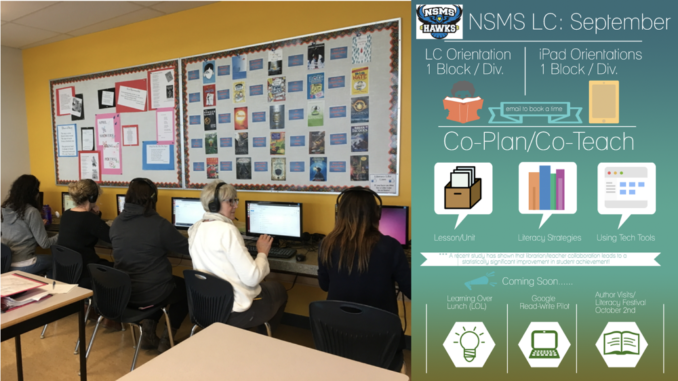
By David Mark and Darcy McNee
Many teachers think of the school #librarian as a resource for students. And they are! But they can be super helpful to teachers too @trev_mackenzie @CdnSchoolLibrar https://t.co/Lo4HwqHO2P #edchat #tlchat #inquiryed
— MindShift (@MindShiftKQED) August 17, 2019
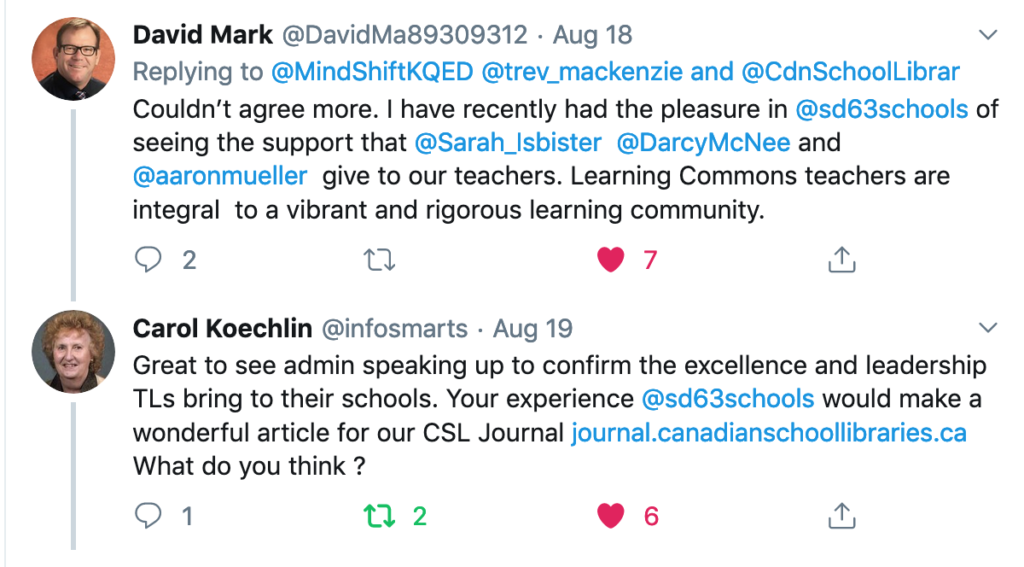
Six years ago North Saanich Middle School was given an amazing opportunity. The school principal, vice principal, and teacher-librarian were all new to their roles and our school had a strong, experienced staff who were ready to try new things. At the same time, the district had strong teacher leaders who were laying the foundation for a vision which reinvented the school library as a learning commons. These crucial factors created the environment to build a vibrant school culture with the learning commons at its heart.
We realize that everyone has their own context and may not have the same opportunities afforded to us; however, over the last several years we have learned many lessons that we feel are transferable to any context. These lessons empowered the teacher-librarian and helped us transform our library to a learning commons. Additionally, they helped us increase student achievement, support staff development, and impact meaningful change.
Start with a Vision
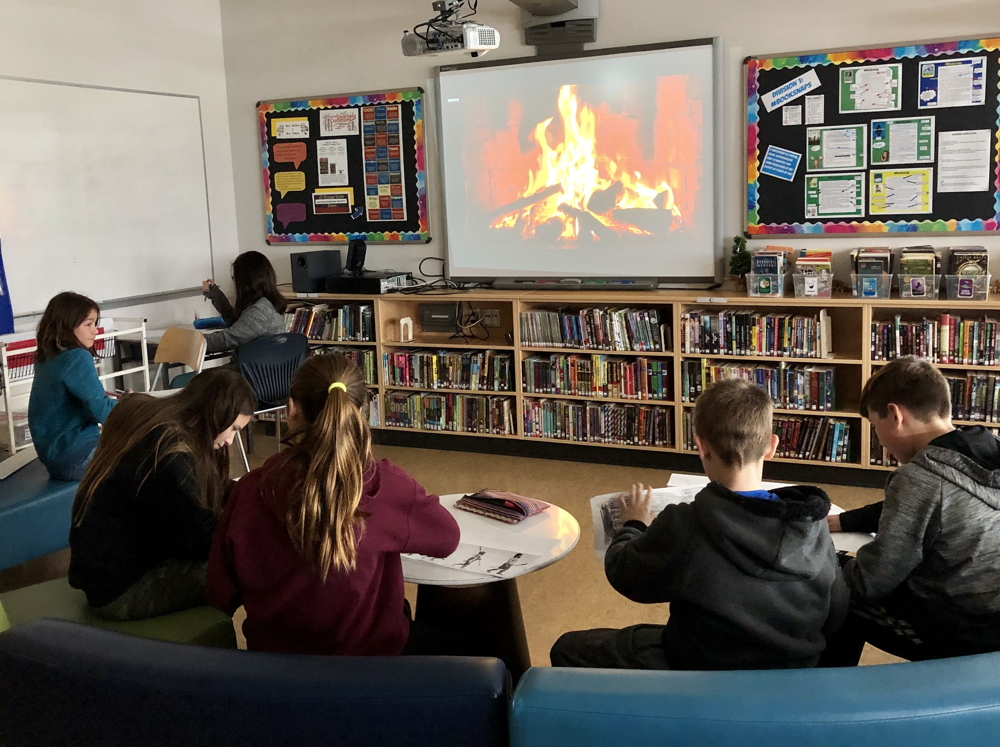
Our school principal, Kal, was instrumental in creating the conditions for our success. When he was a first-year teacher, the teacher-librarian at his school co-taught units with him in English and social studies. She came into the classroom to set the expectations for the unit, provided resources, supported student learning, and then co-assessed student work. This created a rich learning environment for both teachers and students and it helped build consistent expectations and practice throughout the school. Thirty years later, in their strategic vision for the new school, Kal and David hoped to replicate this framework at North Saanich as one of its foundational pieces.
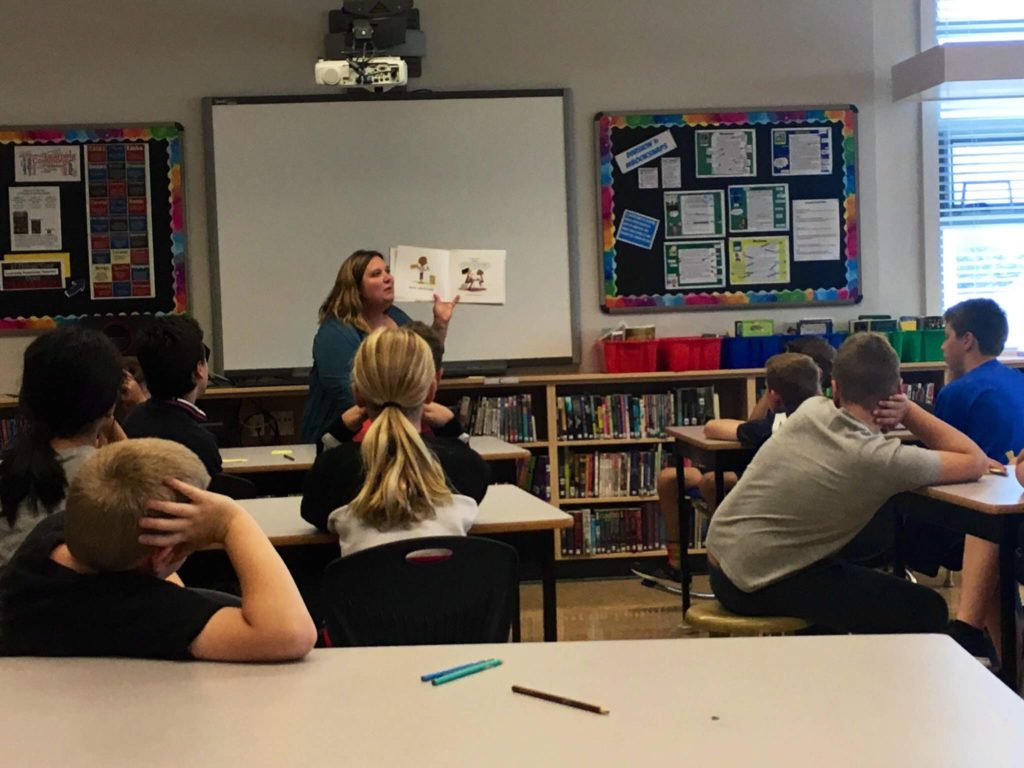
One of Kal’s many talents is recognizing people’s gifts –– often before they themselves know they exist. Kal recognized that Darcy, a classroom teacher at the time, could help him realize his vision for the school library. He encouraged her to consider taking on this new challenge. In doing so, he took some of the first steps toward realizing his vision.
Trust is Key
It wasn’t long before we realized how important trust was between the administrators and the teacher-librarian. School start-up is a very busy time for all educators. As the administration team dove into school management, Darcy dove into textbook distribution and library orientations. After those first few hectic weeks, Darcy was left with many questions. As a new middle school teacher-librarian, she wanted a better picture of where her program fit in terms of what students had experienced in elementary libraries, and what they might expect as they headed toward high school. Darcy went to her administrators to see if she might arrange some school visits to the feeder schools to gain a deeper understanding. Their response was pivotal in terms of Darcy understanding her new position. They told her that they completely trusted her to decide how best to use her time to serve the school community. If Darcy saw the value in making a visit to an elementary or high school library, then she should do so. No permission needed. This trust opened possibilities and allowed our learning commons programs to best meet the needs of our students.
Flexible Schedule
Trusting Darcy to decide how best to use the school library time also meant that administrators trusted her to create a completely flexible library schedule. Book exchange was moved to three times during the school day; homeroom advisory (the first 30 mins of each day), lunch, and recess. During homeroom 3 to 5 students per class were invited to exchange books on an as-needed basis. The library was also open to students during recess and lunch. The rest of the day then became available for co-teaching and collaboration.
Increased time for co-teaching and collaboration came with many benefits. As Darcy worked with more teachers, she was able to help create connections within the school community. In turn, these connections enabled us to build consistent language, practice, and common goals throughout the building. It also helped us develop rich curricular units and sound assessment practices. Additionally, through action research, we found that these collaborative partnerships led to statistically significant growth in student skills (McNee & Radmer, 2017)
Reciprocal Relationships
Flexible scheduling came with additional benefits to the school. Throughout the course of the school year there are several non-negotiables which can create barriers for the daily ebb and flow. These include things such as standardized tests or whole-school surveys. In some schools, these can create extra pressure for administrators. In our situation we were able to use this as an opportunity to provide extra support for teachers.

With some creative scheduling, Darcy was able to use learning commons time to support these non-negotiables. For example, we booked our whole-school surveys during the week report cards were due. Darcy, with support from the administration team, built a schedule that allowed for each class to complete their survey during a block which backed to their teacher’s prep. Darcy would then take each class to complete the surveys, allowing the teacher to have the survey block for reporting. When combined with their prep this created a solid block of time for teachers just when they needed it the most.
Comprehensive Model
Working together to support students, teachers, and school initiatives, the teacher-librarian and the administrators were able to model a team approach that is needed to build a successful learning commons program. With a background in behaviour support and student advocacy David, our vice principal, knew that planning for diversity is a collective responsibility and requires a collective approach. His vision was to position the learning commons as an integral part of our Comprehensive Model.
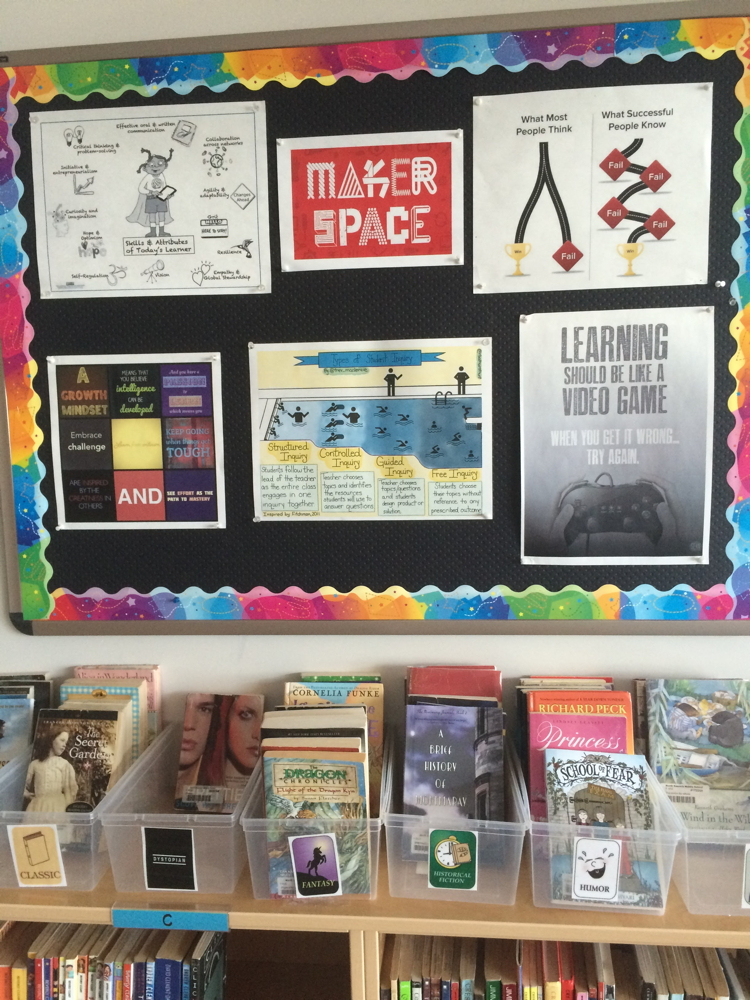
A foundation of Kal and David’s vision was the initiation of the Class Review process as outlined in Learning in Safe Schools (Brownlie & King, 2000). This collaborative data driven process, allowed us to create diversity maps which helped us create access points for all learners and make plans for student success. It provided a consistent perspective that could inform planning and supports at the student, classroom and school level. David asked Darcy to take on a leadership role in this process. As a member of the learning team, and a teacher who worked with all students in all classes, Darcy was able to share valuable perspectives on student learning needs. David also asked Darcy to attend and participate in weekly learning services meetings. Working with Instructional Support Teachers, Darcy was able to learn and model strategies which helped meet the needs of our diverse learners.
Connected Libraries
The administration team also encouraged Darcy to take on additional leadership roles within the school, and in doing so, Darcy was able to connect the learning commons to all members of the school community. For example, Darcy provided tech coaching for educational assistants and presented on adaptive technology for our parent advisory council. In this way, our library became a place where every person, student and adult, engaged in meaningful learning.
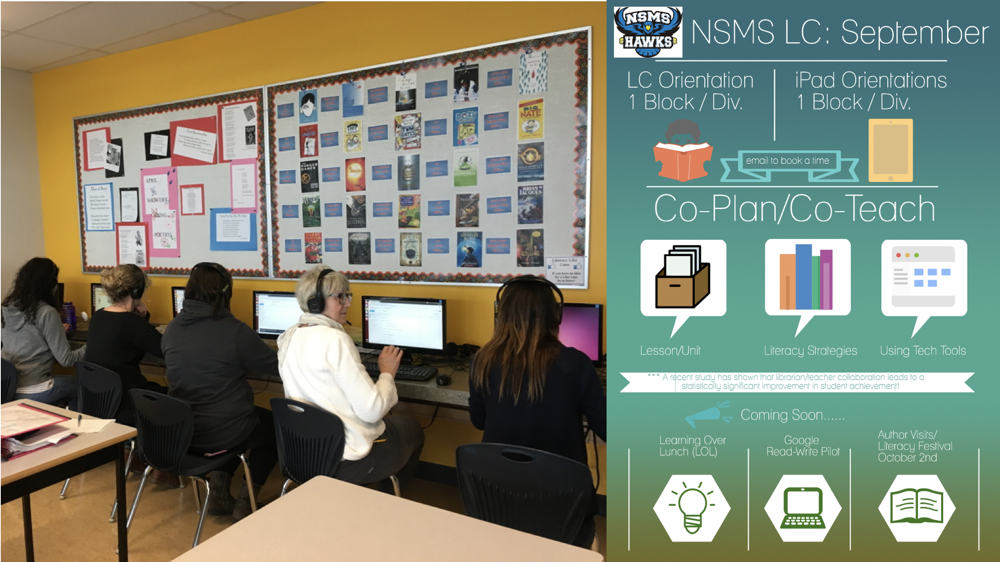
Finally the administrative team encouraged Darcy to make connections outside the school and district. This allowed her to continue to learn and grow within her role.
Administrators play a vital role in creating the conditions for a successful school library learning commons. Through vision, trust, and flexibility administrators lay the foundation. This is enhanced when the teacher-librarian is encouraged to take on additional leadership roles within the school. We realize that we were afforded a unique opportunity when we started together in our new roles. We didn’t have to worry about legacy practice and could reinvent the vision of what we wanted our learning commons to be. By sharing our learning we hope others, no matter their context, can learn strategies to support their vision for their learning commons. Our hope is that administrators and teacher-librarians can work together to realize their full potential. Together they create strong leadership –– and strong leadership builds libraries.
References
Brownlie, F., & King, J. (2000). Learning in safe schools: Creating classrooms where all students belong. Markham, Ont: Pembroke.
McNee, D., & Radmer, E. (2017). Librarians and learning: The impact of collaboration. English Leadership Quarterly, 40(1), 6-9.

David Mark is an Administrator in the Saanich School District. He has worked in public education for 17 years as a Teacher, Behaviour Support Teacher, Student Advocate and Administrator supporting middle and secondary students with and without special needs. David professional focus is to create and support inclusive opportunities that meet students where they are at and move them forward on their learning journey.
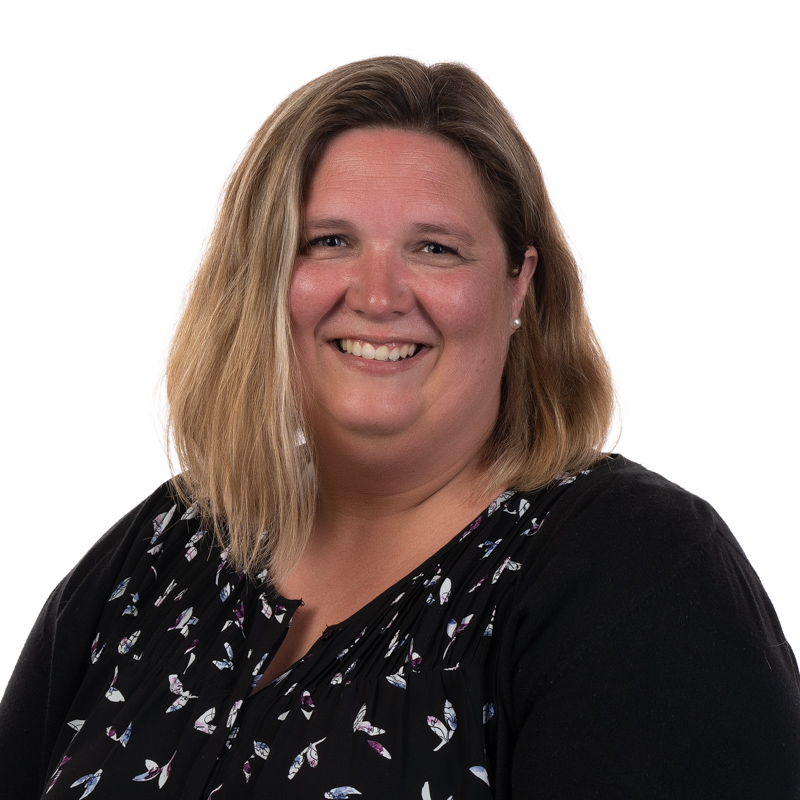
Darcy McNee is a Learning Commons Teacher and a District Teacher Leader for Curriculum and Innovation in the Saanich School District. She is also a sessional instructor for the University of British Columbia’s Teacher-Librarian Diploma Program. Darcy is passionate about learning, literacy, curriculum, collaboration, edtech and assessment.